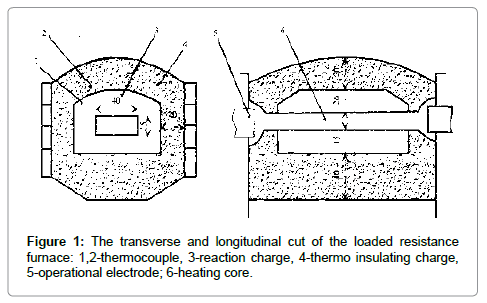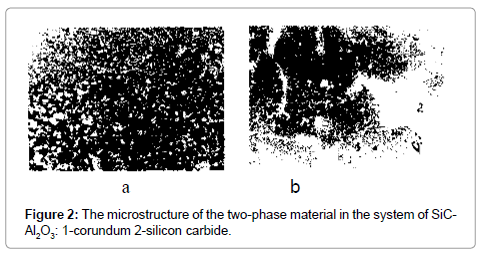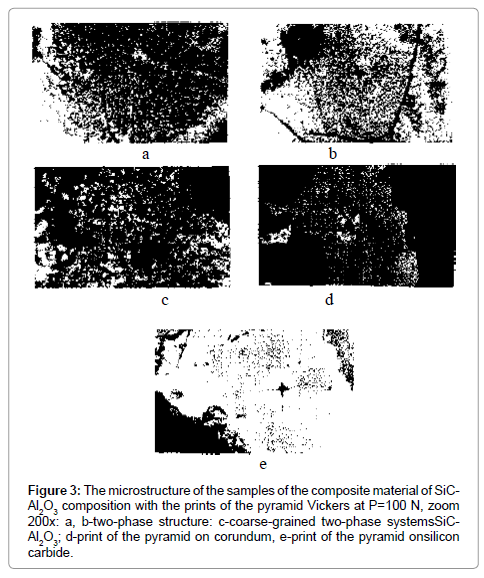Research Article Open Access
High Temperature Composites Sic-Al2O3-Ceramics with Al2O3-Matrix
Garshin AP1*, Shumyacher VM2, Pushkarev OI2 and Kulik VI3
1State Polytechnic University, St. Petersburg, Russia
2State Architectural-Building University, Volgograd, Russia
3Baltic State Technical University, Russia
- *Corresponding Author:
- Garshin AP
State Polytechnic University
St. Petersburg, Russia
E-mail: apgarshin@gmail.com
Received Date: January 21, 2015 Accepted Date: May 14, 2015 Published Date: June 05, 2015
Citation: Garshin AP, Shumyacher VM, Pushkarev OI, Kulik VI (2015) High Temperature Composites Sic-Al2O3-Ceramics with Al2O3-Matrix. J Powder Metall Min 4:131. doi:10.4172/2168-9806.1000131
Copyright: © 2015 Garshin AP, et al. This is an open-access article distributed under the terms of the Creative Commons Attribution License, which permits unrestricted use, distribution, and reproduction in any medium, provided the original author and source are credited.
Visit for more related articles at Journal of Powder Metallurgy & Mining
Abstract
The objective of the present study has consisted in obtaining and studying the properties of the composite material based on silicon carbide and corundum. The synthesis process of the composite material is effected by means of adding aluminum to the traditional charge used in the technology of silicon carbide obtaining by the reaction of SiO2+3C=SiC+2CO (eq 1). The adding of aluminum into the said charge stipulates its flow in accordance with the reaction of SiO2+C+4/3 Al=SiC+2/3 Al2O3 ↔ SiC-Al2O3 (eq 2). The reaction (2) proceeds to form the composite material of the two-phase system SiC-Al2O3 that represents the aggregate of many grains of silicon carbide SiC allocated in the corundum matrix Al2O3.
Keywords
SIC-Al2O3-ceramics; Al2O3-matrix; High temperature composites; Silicon carbide; Corundum
Introduction
Al2O3 based composites have been extensively studied because of their excellent properties such as high hardness, low electrical conductivity, good chemical stability and oxidation resistance. Most researches focus on particle-dispersed Al2O3 composites in order to improve their mechanical properties including flexural strength and fracture toughness. The second phase particles contain SiC [1], ZrO2, TiN/TiC/TiO2, BN and metal particle such as Cr providing a fine-grained microstructure through adding particles, the strength is enhanced. The fracture toughness is improved due to crack deflection, micro crack, and grain bridging. Al2O3 ceramic has a good sintering property, but excessive addition of carbide or nitride results in the generation of pores [2].
Experimental Procedure
In the experiment the initial charge was prepared from silica sand, aluminum powder and petroleum coke in accordance with assumed stoichiometric ratio (equation 2). As silicon oxide quartz sand was used with SiO2 content not less than 99.1% and Fe2O3 content not more than 0.25%. Aluminum and carbonaceous material was introduced into the charge in the form of aluminum powder of APV grade and low-sulfur petroleum coke with 80 - 85% content of active carbon. The process of obtaining the composite material out of the said charge was carried out in a laboratory resistance furnace of 160 kW power capacities, the working length of which was 1300 mm while its width was 1100 mm (Figure 1).
The temperature control in the furnace was performed by an optical pyrometer by means of special visual tube. From the products obtained through synthesis the samples were prepared by the method of dry grinding in a jaw crusher and from a fraction of minus 5 mm the fractions of 1600-1250 microns were plated, on which chemical, microscopic, micro X-ray spectrum analyzes were performed, micromechanical studies were carried out as well as operational characteristics of the grains of the composite material were identified in the grinding instrument according to the method set out in the works [2,3]. X-ray structural analysis was performed by the photo-method on the apparatus URS-55 in copper, filtered radiation, in Debye camera. The study of the microstructure was performed on micro sections, prepared on a cast-iron lap with the use of the diamond pastes of ASM 20/14-ASM 1/0 grades, the samples were photographed by the microscopes MIM-8 and PMT-3 with 500X zoom.
When studying micro-mechanical properties of the composite material with the use of PMT-3 device we have identified micro hardness and micro strength of separate phases of silicon carbide and corundum as well as of the composite abrasive material with SiC-Al2O3 composition according to the method [2,3] when there is load on the indenter of Vickers pyramid as 100 N.
Micro X-ray spectrum analysis was performed on micro analyzer MAP-2 with the use of metallic aluminum and silicon carbide as the standard. Physical and mechanical characteristics were identified by means of instrumentation and control methods of grinding materials, those methods were developed by us [2-4].
Results and Discussion
The chemical and X-ray studies have revealed that all the objects taken from the zone of the synthesis products contain 35-40% SiC and 60-65% Al2O3. In all samples the aluminum oxide is in the form of α-A2O3 while silicon carbide is typically manifested as a mixture of cubic (β-SiC) and hexagonal (α-SiC) silicon carbide. By the analysis of the microstructure and the results of micro X-ray spectrum analysis the synthesized product represents the material with fine grained twophase structure (the size of the phases is from 2 to 40 microns) (Figure 2a): grey phase–corundum, light phase-silicon carbide. The areas of fine grained two-phase structure make from 30 to 80% in total volume of the products; up to 10% is formed by the areas of large entities of corundum and silicon carbide, in which the size of phases ranges from 50 to 200 microns and more (Figure 2b).
Figure 3 shows the microstructure of the areas with fine and coarse particles of the two-phase systems of the composite material based on SiC-Al2O3 with prints of Vickers pyramid (Figure 3a-c) and areas of separate phases of corundum and silicon carbide (Figure 3d and e), at the same time among the systems of the composite material the areas of different inclusions are observed, too.
Figure 3: The microstructure of the samples of the composite material of SiCAl 2O3 composition with the prints of the pyramid Vickers at P=100 N, zoom 200x: a, b-two-phase structure: c-coarse-grained two-phase systemsSiCAl 2O3; d-print of the pyramid on corundum, e-print of the pyramid onsilicon carbide.
Table 1 shows the data on micro hardness and micro strength of the composite material SiC-Al2O3 compared to single-component constituents of the composite materials SiC and Al2O3.
The obtained results (Table 1) demonstrate that the composite material SiC-Al2O3 by its micro-hardness is close to SiC while by its micro strength it is significantly superior to both silicon carbide and corundum.
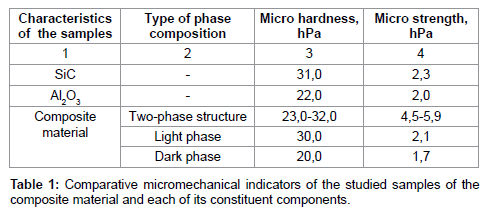
Physical and mechanical properties of the composite material SiCA2O3, obtained at different content of aluminum in reaction charge, are shown in Table 2.
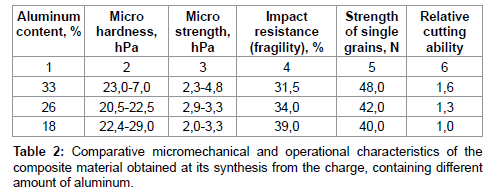
The analysis of the data in Table 2 demonstrates that to the greater amount of aluminum in the charge the composite material of higher quality corresponds (micro strength, strength of single grains, relative cutting ability has higher values).
To assess the possibility of producing an abrasive tool from the composite material under laboratory conditions we have made grinding abrasive wheels from it and performed tests in comparison to similar grinding wheels made only from silicon carbide and only from corundum. The analysis of the achieved results has shown that grinding wheels from the composite material SiC-Al2O3 when ShH-15 steel, iron-cast and titanium alloys were processed by them they have the grinding ability is 30% higher, than the similar products made only from silicon carbide and only from corundum.
Conclusion
The results of the studies carried out in the present work allow us to conclude that we have obtained the new composite abrasive material SiC-Al2O3 with corundum matrix, the material that possesses the new properties different from both silicon carbide properties and corundum properties. That is why the composite material in question may be recommended for producing abrasive tools from it for processing (grinding) products made of S e hH-15 steel, iron-cast and titanium alloys. The studies aimed to determine the areas of the composite material SiC-Al2O3 application will be continued.
References
- Garshin AP (2006)Silicon carbide, Mono-crystals, powders and products based on them. St.Petersburg.: Printing house of Polytechnic University.
- Garshin AP, Shumyacher VM, Pushkarev OI (2008)Abrasives andmaterials of construction designation based on Silicon Volgograd.
- Pushkarev OI (2002) Studies of the strength surfaces and resistance to cracks of highly rigid ceramic materials by the method of micro impression.
- Garshin AP, Lavrenova EA, Vodakov Yu A, Mokhov EN. Influence of Impurities and Intrinsic Defects Physicomechanical Properties of Silicon Carbide Single Crystals.
Relevant Topics
- Additive Manufacturing
- Coal Mining
- Colloid Chemistry
- Composite Materials Fabrication
- Compressive Strength
- Extractive Metallurgy
- Fracture Toughness
- Geological Materials
- Hydrometallurgy
- Industrial Engineering
- Materials Chemistry
- Materials Processing and Manufacturing
- Metal Casting Technology
- Metallic Materials
- Metallurgical Engineering
- Metallurgy
- Mineral Processing
- Nanomaterial
- Resource Extraction
- Rock Mechanics
- Surface Mining
Recommended Journals
Article Tools
Article Usage
- Total views: 15184
- [From(publication date):
August-2015 - Apr 02, 2025] - Breakdown by view type
- HTML page views : 10509
- PDF downloads : 4675

